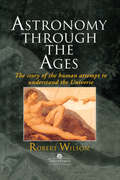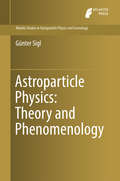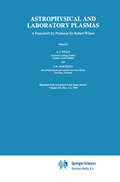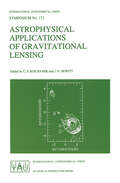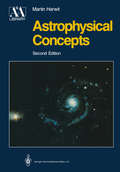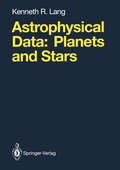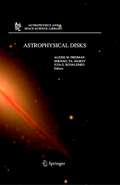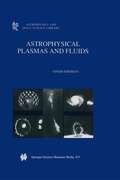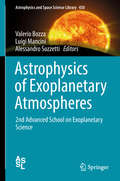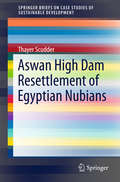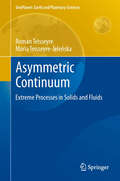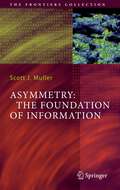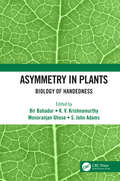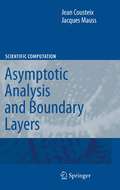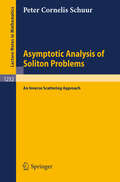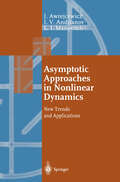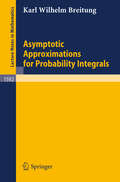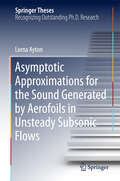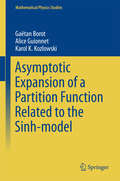- Table View
- List View
Astronomy Through the Ages: The Story Of The Human Attempt To Understand The Universe
by Sir Robert WilsonFrom an historical perspective, this text presents an entirely non- mathematical introduction to astronomy from the first endeavours of the ancients to the current developments in research enabled by cutting edge technological advances. Free of mathematics and complex graphs, the book nevertheless explains deep concepts of space and time, of relativity and quantum mechanics, and of origin and nature of the universe. It conveys not only the intrinsic fascination of the subject, but also the human side and the scientific method as practised by Kepler, defined and elucidated by Galileo, and then demonstrated by Newton.
Astronomy Through the Ages: The Story Of The Human Attempt To Understand The Universe (Princeton Legacy Library #4827)
by Sir Robert WilsonFrom an historical perspective, this text presents an entirely non- mathematical introduction to astronomy from the first endeavours of the ancients to the current developments in research enabled by cutting edge technological advances. Free of mathematics and complex graphs, the book nevertheless explains deep concepts of space and time, of relativity and quantum mechanics, and of origin and nature of the universe. It conveys not only the intrinsic fascination of the subject, but also the human side and the scientific method as practised by Kepler, defined and elucidated by Galileo, and then demonstrated by Newton.
Astroparticle Physics: Theory and Phenomenology (Atlantis Studies in Astroparticle Physics and Cosmology #1)
by Günter SiglThis books aims at giving an overview over theoretical and phenomenological aspects of particle astrophysics and particle cosmology. To be of interest for both students and researchers in neighboring fields of physics, it keeps a balance between well established foundations that will not significantly change in the future and a more in-depth treatment of selected subfields in which significant new developments have been taking place recently. These include high energy particle astrophysics, such as cosmic high energy neutrinos, the interplay between detection techniques of dark matter in the laboratory and in high energy cosmic radiation, axion-like particles, and relics of the early Universe such as primordial magnetic fields and gravitational waves. It also contains exercises and thus will be suitable for both introductory and advanced courses in astroparticle physics.
Astrophysical and Laboratory Plasmas: A Festschrift for Professor Sir Robert Wilson
by A. J. Willis T. W. HartquistAstrophysical Applications of Gravitational Lensing: Proceedings of the 173rd Symposium of the International Astronomical Union, Held in Melbourne, Australia, 9–14 July, 1995 (International Astronomical Union Symposia #173)
by C. S. Kochanek J. N. HewittEDWIN TURNER AND RACHEL WEBSTER Co-Chairs, Scientific Organizing Committee lAU Symposium 173, Astrophysical Applications of Gravitational Lenses, was held in Melbourne, Australia from July 9-14, 1995. The Symposium was sponsored by lAU Commissions 47 and 40. With the discovery by Walsh and collaborators of the first instance of a gravitational lens, the multiply imaged quasar 0957+561, the area of grav itational lensing moved from speculative theory to a major astrophysical tool. Since that time, there have been regular, approximately biennial in ternational meetings both in Europe and in North America, which have specifically focussed on gravitational lensing. On this occasion, with the blessing of the lA U, the meeting was held at the University of Melbourne in Australia. It was the first international astronomical meeting to be held at the University of Melbourne, and hope fully has given the astronomical community some enthusiasm for trekking half-way round the globe to Australia to discuss their latest work.
Astrophysical Concepts (Astronomy and Astrophysics Library)
by Martin HarwitMy principal aim in writing this book was to present a wide range of astrophysical topics in sufficient depth to give the reader a general quantitative understanding of the subject. The book outlines cosmic events but does not portray them in detail-it provides aseries of astrophysical sketches. I think this approach befits the present uncertainties and changing views in astrophysics. The material is based on notes I prepared for a course aimed at seniors and beginning graduate students in physics and astronomy at Cornell. This course defined the level at which the book is written. For readers who are versed in physics but are unfamiliar with astronomical terminology, Appendix A is included. It gives a brief background of astronomical concepts and should be read before starting the main text. The first few chapters outline the scope of modern astrophysics and deal with elementary problems concerning the size and mass of cosmic objects. However, it soon becomes apparent that a broad foundation in physics is needed to proceed. This base is developed in Chapters 4 to 7 by using, as ex am pIes, specific astronomi cal situations. Chapters 8 to 10 enlarge on the topics first outlined in Chapter I and show how we can obtain quantitative insights into the structure and evolution of stars, the dynamics of co~mic gases, and the large-scale behavior of the universe.
Astrophysical Data: Planets and Stars
by Kenneth R. LangThis volume of Astrophysical Data deals with Planets and Stars; a second volume, Part II, will give data for Galaxies and the Universe. They both pro vide basic data for use by all scientists, from the amateur astronomer to the professional astrophysicist. In this first volume, we not only provide physical parameters of planets, stars and their environment, but we also provide the celestial coordinates required to observe them. Here we use c.g.s. units, for they are the most commonly used in astron omy and astrophysics; but our volume begins with astronomical and physical constants and the conversion factors needed for other units. The next section concerns the planets and their satellites; it singles out the Earth and Moon for special treatment. Spacecraft rendezvous with the planets and satellites have led to improved values for their atmospheric compositions, orbital parameters, magnetic fields, masses, radii, rotation periods, and surface pressures and temperatures. This section also contains data for the asteroids, comets and their debris. We then discuss everyday stars, beginning with the Sun, and continuing with basic stellar data, the brightest stars and nearby stars. Special categories of stars, such as the Wolf-Rayet stars, magnetic stars, flare stars, and RS CVn binary stars, are included.
Astrophysical Disks: Collective and Stochastic Phenomena (Astrophysics and Space Science Library #337)
by Aleksey M. Fridman Mikhail Ya Marov Ilya G. KovalenkoThis book deals with collective and stochastic processes in astrophysical disks involving theory, observations, and the results of modelling. It examines the spiral-vortex structure in galactic and accretion disks, and stochastic and ordered structures in developed turbulence. The book advances the study in this important branch of astrophysics and will benefit professional researchers, lecturers, and graduate students.
Astrophysical Plasmas and Fluids (Astrophysics and Space Science Library #235)
by VINOD BalakrishnanLife was simple when the dynamic, the spectral and the resolving powers of our instruments were small. One observed whole objects - planets, stars, sunspots, galaxies, often in rainbow colours. Then the revolution occurred: we acquired the centimetric eyes, the mil limetric eyes, the infrared eyes, the ultraviolet eyes, the X-ray eyes and the ,-ray eyes. With these we see mottles on the surface of stars, streams in sunspots, and spirals in nuclei of galaxies. We see regions of multiple mass densities and temperatures in a precari ous balance, losing it occasionally, exhaling flares. The universe is timed, cosmic phenomena are clocked; eternity is lost and variabil ity is bought. Microarcsecond resolutions revealed stirring and siz zling interiors underneath serene surfaces. Short durations and small scales demanded employing a discipline with similar attributes - the discipline of Plasmas and Fluids - known more for its complexity than for its felicity. Some would like to wish it away. We shall learn about plasmas for it is too little familiarity that breeds fear. Complexity can be systemized, to a large extent, by looking for a common denominator among apparently disparate phe nomena. It is not immediately obvious what the contents and the style of a graduate level course on plasmas and fluids aimed at understanding astrophysical phenomena should be. Plasmas and fluids are huge subjects by themselves. The cosmic phenomena where plasmas and fluids playa definite role are equally diverse and numerous.
Astrophysics of Exoplanetary Atmospheres: 2nd Advanced School on Exoplanetary Science (Astrophysics and Space Science Library #450)
by Valerio Bozza Luigi Mancini Alessandro SozzettiIn this book, renowned scientists describe the complexity of exoplanetary atmospheres and all of the observational techniques that are employed to probe them. Readers will also find a panoramic description of the atmospheres of the planets within the Solar System, with explanation of considerations especially relevant to exoplanets. Over the past few years, thousands of exoplanets have been discovered orbiting around stars relatively close to the Solar System. Astronomers have revealed how varied these exoplanets are (rocky, icy, giant) and how diverse their architecture can be, confirming science fiction images in several cases and extending beyond the human imagination in others. The natural next step is to study their atmospheres and to understand their chemical composition and the physical processes taking place in their interiors, with the aim of detecting biomarkers. This book will appeal to all who seek a comprehensive, state-of-the-art account of the latest knowledge in the rapidly developing and highly interdisciplinary field of exoplanet research.
Aswan High Dam Resettlement of Egyptian Nubians (SpringerBriefs on Case Studies of Sustainable Development)
by Thayer ScudderThis book highlights the long-term resettlement process of the Egyptian Nubian people along the Aswan High Dam. Assessing the resettlement of 48,000 Egyptian Nubians in connection with the High Dam is especially important for three main reasons: firstly, this resettlement process is one of the rare cases in which research begun before the dam was built has continued for over forty years. Secondly, the resettlement of the Egyptian Nubian people is one of the few cases in which the living standards of the large majority improved because of the initial political will of the government, combined with Nubian initiatives. Thirdly, given the complexity of the resettlement process, weaknesses in government planning, implementation, and in the weakening of government political provide valuable lessons for future dam-induced resettlement efforts.
Asylum Seekers (large print)
by RnibThese pages show bar graphs relating to asylum seekers. It is a multi-page image set on two pages. There is a locator dot shown on each page, which will be at the top left, when the image is the correct way up. Asylum seekers allowed to stay in the UK: The X-axis at the bottom of the page shows time in years and is labelled every two years. The Y-axis is on the left of the page and shows the numbers of asylum seekers in thousands. It is labelled every two thousand people. The bars are vertical, starting and ending low with a high peak in 2003. The exact number of people is labelled at the top of each bar. Proportion of UK population with a degree or higher qualification: The X-axis at the bottom of the page shows the percentage of the population, marked every ten and labelled every twenty percentage points. The bars are horizontal and labelled at the end of each bar.
Asylum Seekers (UEB contracted)
by RnibThese pages show bar graphs relating to asylum seekers. It is a multi-page image set on two pages. There is a locator dot shown on each page, which will be at the top left, when the image is the correct way up. Asylum seekers allowed to stay in the UK: The X-axis at the bottom of the page shows time in years and is labelled every two years. The Y-axis is on the left of the page and shows the numbers of asylum seekers in thousands. It is labelled every two thousand people. The bars are vertical, starting and ending low with a high peak in 2003. The exact number of people is labelled at the top of each bar. Proportion of UK population with a degree or higher qualification: The X-axis at the bottom of the page shows the percentage of the population, marked every ten and labelled every twenty percentage points. The bars are horizontal and labelled at the end of each bar.
Asylum Seekers (UEB uncontracted)
by RnibThese pages show bar graphs relating to asylum seekers. It is a multi-page image set on two pages. There is a locator dot shown on each page, which will be at the top left, when the image is the correct way up. Asylum seekers allowed to stay in the UK: The X-axis at the bottom of the page shows time in years and is labelled every two years. The Y-axis is on the left of the page and shows the numbers of asylum seekers in thousands. It is labelled every two thousand people. The bars are vertical, starting and ending low with a high peak in 2003. The exact number of people is labelled at the top of each bar. Proportion of UK population with a degree or higher qualification: The X-axis at the bottom of the page shows the percentage of the population, marked every ten and labelled every twenty percentage points. The bars are horizontal and labelled at the end of each bar.
Asymmetric Continuum: Extreme Processes in Solids and Fluids (GeoPlanet: Earth and Planetary Sciences #3)
by Roman Teisseyre Maria Teisseyre-JeleńskaThis book deals with a class of basic deformations in Asymmetric Continuum Theory. It describes molecular deformations and transport velocities in fluids, strain deformations in solids as well as the molecular transport, important in fracture processes. In solids, a separate problem relates to the displacements; their recording, e.g., by means of the seismometers, proves only the existence of the displacement derivatives and not a real displacement. However, the molecular displacements and new fracture criterion including the defect distributions and induced strains are defined in the book too. In fluids, the transport velocities and molecular strains describe the motion processes. The vortex motions are defined by means of the rotational transport; this approach leads to more complicated problems, like the turbulence phenomena. The interaction processes, including the electric and magnetic fields, and some thermodynamical problems and quantum theory analogies help to understand the extreme processes
Asymmetry: The Foundation of Information (The Frontiers Collection)
by Scott J. MullerThis book gathers concepts of information across diverse fields –physics, electrical engineering and computational science – surveying current theories, discussing underlying notions of symmetry, and showing how the capacity of a system to distinguish itself relates to information. The author develops a formal methodology using group theory, leading to the application of Burnside's Lemma to count distinguishable states. This provides a tool to quantify complexity and information capacity in any physical system.
Asymmetry in Plants: Biology of Handedness
by Bir Bahadur K. V. Krishnamurthy Manoranjan Ghose S. John AdamsPlants exhibit forms of asymmetry analogous to "handedness" in bilaterally symmetrical animals. This book explores the evolutionary significance and development of asymmetry. Examples of genetic control include the direction of tendril or stem coiling of many climbing plants; the so-called spiral phyllotaxy and floral taxy; and contorted petal arrangement is another kind of left- right symmetry in plants; the direction of contortion is fixed in some but not in other plants. The book will underscore tha all phenomena related to handedness start during embryogenesis itself, with the occurrence of embryo rotation. Key selling features: First consolidated book on Plant Handedness Relates handedness, asymmetry and chirality to the evolution of different organizational levels in plant biology Emphasizes handedness as a vital governing force in plant functional evolution Provides a new perspective, hitherto ignored, into plant developemtn and evolution Describes how an age-old phenomenon can give scope for investigation from a very modern interdisciplinary approach
Asymmetry in Plants: Biology of Handedness
by Bir Bahadur K. V. Krishnamurthy Monoranjan Ghose S. John AdamsPlants exhibit forms of asymmetry analogous to "handedness" in bilaterally symmetrical animals. This book explores the evolutionary significance and development of asymmetry. Examples of genetic control include the direction of tendril or stem coiling of many climbing plants; the so-called spiral phyllotaxy and floral taxy; and contorted petal arrangement is another kind of left- right symmetry in plants; the direction of contortion is fixed in some but not in other plants. The book will underscore tha all phenomena related to handedness start during embryogenesis itself, with the occurrence of embryo rotation. Key selling features: First consolidated book on Plant Handedness Relates handedness, asymmetry and chirality to the evolution of different organizational levels in plant biology Emphasizes handedness as a vital governing force in plant functional evolution Provides a new perspective, hitherto ignored, into plant developemtn and evolution Describes how an age-old phenomenon can give scope for investigation from a very modern interdisciplinary approach
Asymptotic Analysis and Boundary Layers (Scientific Computation)
by Jean Cousteix Jacques MaussThis book presents a new method of asymptotic analysis of boundary-layer problems, the Successive Complementary Expansion Method (SCEM). The first part is devoted to a general presentation of the tools of asymptotic analysis. It gives the keys to understand a boundary-layer problem and explains the methods to construct an approximation. The second part is devoted to SCEM and its applications in fluid mechanics, including external and internal flows.
Asymptotic Analysis of Soliton Problems: An Inverse Scattering Approach (Lecture Notes in Mathematics #1232)
by Peter Cornelis SchuurAsymptotic Approaches in Nonlinear Dynamics: New Trends and Applications (Springer Series in Synergetics #69)
by Jan Awrejcewicz Igor V. Andrianov Leonid I. ManevitchThis book covers developments in the theory of oscillations from diverse viewpoints, reflecting the fields multidisciplinary nature. It introduces the state-of-the-art in the theory and various applications of nonlinear dynamics. It also offers the first treatment of the asymptotic and homogenization methods in the theory of oscillations in combination with Pad approximations. With its wealth of interesting examples, this book will prove useful as an introduction to the field for novices and as a reference for specialists.
Asymptotic Approximations for Probability Integrals (Lecture Notes in Mathematics #1592)
by Karl W. BreitungThis book gives a self-contained introduction to the subject of asymptotic approximation for multivariate integrals for both mathematicians and applied scientists. A collection of results of the Laplace methods is given. Such methods are useful for example in reliability, statistics, theoretical physics and information theory. An important special case is the approximation of multidimensional normal integrals. Here the relation between the differential geometry of the boundary of the integration domain and the asymptotic probability content is derived. One of the most important applications of these methods is in structural reliability. Engineers working in this field will find here a complete outline of asymptotic approximation methods for failure probability integrals.
Asymptotic Approximations for the Sound Generated by Aerofoils in Unsteady Subsonic Flows (Springer Theses)
by Lorna AytonThis thesis investigates the sound generated by solid bodies in steady subsonic flows with unsteady perturbations, as is typically used when determining the noise generated by turbulent interactions. The focus is predominantly on modelling the sound generated by blades within an aircraft engine, and the solutions are presented as asymptotic approximations. Key analytical techniques, such as the Wiener-Hopf method, and the matched asymptotic expansion method are clearly detailed. The results allow for the effect of variations in the steady flow or blade shape on the noise generated to be analysed much faster than when solving the problem numerically or considering it experimentally.
Asymptotic Expansion of a Partition Function Related to the Sinh-model (Mathematical Physics Studies)
by Gaëtan Borot Alice Guionnet Karol K. KozlowskiThis book elaborates on the asymptotic behaviour, when N is large, of certain N-dimensional integrals which typically occur in random matrices, or in 1+1 dimensional quantum integrable models solvable by the quantum separation of variables. The introduction presents the underpinning motivations for this problem, a historical overview, and a summary of the strategy, which is applicable in greater generality. The core aims at proving an expansion up to o(1) for the logarithm of the partition function of the sinh-model. This is achieved by a combination of potential theory and large deviation theory so as to grasp the leading asymptotics described by an equilibrium measure, the Riemann-Hilbert approach to truncated Wiener-Hopf in order to analyse the equilibrium measure, the Schwinger-Dyson equations and the boostrap method to finally obtain an expansion of correlation functions and the one of the partition function. This book is addressed to researchers working in random matrices, statistical physics or integrable systems, or interested in recent developments of asymptotic analysis in those fields.
Asymptotic Expansions and Summability: Application to Partial Differential Equations (Lecture Notes in Mathematics #2351)
by Pascal RemyThis book provides a comprehensive exploration of the theory of summability of formal power series with analytic coefficients at the origin of Cn, aiming to apply it to formal solutions of partial differential equations (PDEs). It offers three characterizations of summability and discusses their applications to PDEs, which play a pivotal role in understanding physical, chemical, biological, and ecological phenomena. Determining exact solutions and analyzing properties such as dynamic and asymptotic behavior are major challenges in this field. The book compares various summability approaches and presents simple applications to PDEs, introducing theoretical tools such as Nagumo norms, Newton polygon, and combinatorial methods. Additionally, it presents moment PDEs, offering a broad class of functional equations including classical, fractional, and q-difference equations. With detailed examples and references, the book caters to readers familiar with the topics seeking proofs or deeper understanding, as well as newcomers looking for comprehensive tools to grasp the subject matter. Whether readers are seeking precise references or aiming to deepen their knowledge, this book provides the necessary tools to understand the complexities of summability theory and its applications to PDEs.
